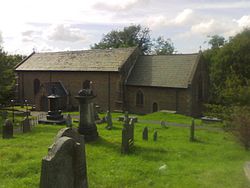Difference between revisions of "Llangyfelach"
(Created page with "{{infobox town |county=Glamorgan |picture=Llangyfelach Church 496035 76e0684e.jpg|240px]] |picture caption=The Parish Church of St David and Cyfelach |latitude =51.67209 |long...") |
|||
| Line 1: | Line 1: | ||
{{infobox town | {{infobox town | ||
|county=Glamorgan | |county=Glamorgan | ||
| − | |picture=Llangyfelach Church 496035 76e0684e.jpg | + | |picture=Llangyfelach Church 496035 76e0684e.jpg |
|picture caption=The Parish Church of St David and Cyfelach | |picture caption=The Parish Church of St David and Cyfelach | ||
|latitude =51.67209 | |latitude =51.67209 | ||
| Line 12: | Line 12: | ||
|os grid ref=SS646988 | |os grid ref=SS646988 | ||
}} | }} | ||
| − | '''Llangyfelach''' is a village and ancient parish in [[Glamorgan]] that forms a northern suburb [[Swansea]]. It is situated about four miles north of the centre of Swansea, just west of [[Morriston]]. To the west is open moorland. | + | '''Llangyfelach''' is a village and ancient parish in [[Glamorgan]] that forms a northern suburb of [[Swansea]]. It is situated about four miles north of the centre of Swansea, just west of [[Morriston]]. To the west is open moorland. |
Bordering the village to the north is the [[M4 motorway]] Junction 46. The village has its own primary school, crematorium, a former post office, The 'Plough and Harrow' pub, and a Scout hall. | Bordering the village to the north is the [[M4 motorway]] Junction 46. The village has its own primary school, crematorium, a former post office, The 'Plough and Harrow' pub, and a Scout hall. | ||
| − | At the centre of the village is the Parish Church of St David and Cyfelach. The site dates back to the 6th | + | At the centre of the village is the Parish Church of St David and Cyfelach. The site dates back to the 6th century: St David founded an early Celtic monastery there. The present church has a 12th-century detached tower and a converted tithe barn as the present church. Contained within the church is the Llangyfelach Cross, a 9th-century Celtic stone. |
The ancient parish stretches as far as the [[Carmarthenshire]] border and comprises the township of Clase, tything of Mawr and the hamlets of Penderry and Rhyndwyclydach. It gives its name to the [[Llangyfelach Hundred]] which occupies the north-eastern portion of the county. | The ancient parish stretches as far as the [[Carmarthenshire]] border and comprises the township of Clase, tything of Mawr and the hamlets of Penderry and Rhyndwyclydach. It gives its name to the [[Llangyfelach Hundred]] which occupies the north-eastern portion of the county. | ||
Latest revision as of 13:40, 17 November 2017
| Llangyfelach | |
| Glamorgan | |
|---|---|
 The Parish Church of St David and Cyfelach | |
| Location | |
| Grid reference: | SS646988 |
| Location: | 51°40’20"N, 3°57’30"W |
| Data | |
| Post town: | Swansea |
| Postcode: | SA5 & SA6 |
| Dialling code: | 01792 |
| Local Government | |
| Council: | Swansea |
| Parliamentary constituency: |
Gower |
Llangyfelach is a village and ancient parish in Glamorgan that forms a northern suburb of Swansea. It is situated about four miles north of the centre of Swansea, just west of Morriston. To the west is open moorland.
Bordering the village to the north is the M4 motorway Junction 46. The village has its own primary school, crematorium, a former post office, The 'Plough and Harrow' pub, and a Scout hall.
At the centre of the village is the Parish Church of St David and Cyfelach. The site dates back to the 6th century: St David founded an early Celtic monastery there. The present church has a 12th-century detached tower and a converted tithe barn as the present church. Contained within the church is the Llangyfelach Cross, a 9th-century Celtic stone.
The ancient parish stretches as far as the Carmarthenshire border and comprises the township of Clase, tything of Mawr and the hamlets of Penderry and Rhyndwyclydach. It gives its name to the Llangyfelach Hundred which occupies the north-eastern portion of the county.
Famous people
Llangyfelach was the birthplace of the painter Evan Walters, and is mentioned in a folk song about the practice of 'pressing' men into military service.[1]
References
- ↑ The Welsh Academy Encyclopedia of Wales. Cardiff: University of Wales Press 2008